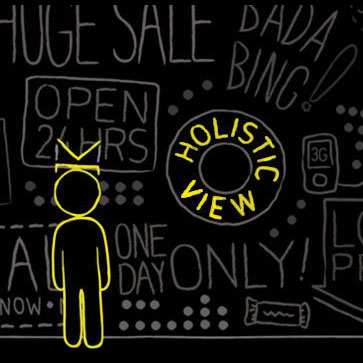The Pulse of 'Net Advertising

There is no better indicator of the health of the digital industry than advertising.
Every time you turn your virtual head, another report touting advertising's exceptional growth, bright future and positive impact on the broader world economy is made available.
Advertising, in many ways, makes the ecosystem function and for that reason, it is essential for Web professionals to know all they can about its current health and long-term outlook.
Digital advertising has its problems of course (name a channel that doesn't - we're looking at you social media), but for all intents and purposes, the pulse of the online advertising industry is strong and incredibly vibrant.
Much like an annual checkup with a doctor, in this edition of Website Magazine, readers will discover just how strong the industry really is, how they can meet their objectives by aligning them with the many available opportunities and learn to identify the greatest challenges in the way of their complete Web wellness. More importantly, readers will discover tips and resources to make their brand's advertising more meaningful, more engaging, and yes, more effective too.
The Signs of Success
Medical professionals ask patients how things are going during the start of a routine visit in order to gain a quick understanding of what they're dealing with in that moment. Physicians then use verbal and non-verbal clues and past benchmarks to make a diagnosis to determine when further appointments or tests are needed or, hopefully, to give a clean bill of health. In our particular case, Internet professionals don't need to look very far to conclude that advertising is healthier than it was last year and passes nearly every checkup criteria.
Search marketing firm Covario, for example, recently issued its Global Paid Search Spend Analysis for the fourth quarter of 2013 and found that spending on pay-per-click ads by its own global technology, consumer electronics and retail clients rose 13 percent from the third quarter and 7 percent year-over year. Covario's findings were typical of the record-breaking 2013 holiday season.
It's not all perfect in the world of search-based advertising of course; Covario also indicated that the average cost-per-click increased 10 percent versus the same period one year ago. According to the report's author, Alex Funk, director of global paid media strategy at Covario, "CPC pricing has been fluctuating over the past few quarters, something not surprising after the platform overhaul that Google AdWords went through at the midway point of 2013."
Search-based advertising is doing quite well obviously (despite the near-constant rate of change), but display advertising has also made a comeback and it's quickly becoming bigger than ever. Nielsen's quarterly evaluation of the global advertising market shows that Internet display advertising grew by more than 32 percent in the first three quarters of 2013. Overall advertising, in comparison, grew just 3.2 percent across all media to hit $243.5 billion at the end of Q3 2013 (still dominated by television).
What these data points illustrate is that despite the immense amount of activity and pace of development in the digital advertising space, there's not much in the way of uncertainty on the part of enterprises who are apparently more than willing to keep spending to acquire awareness, new users and stay ahead of the competition.
Get Emotional - BehaviorMatrix, an applied behavior analytics company, has been granted a patent that essentially covers a method for detecting and measuring emotional signals within digital content, which could prove very useful in the online advertising and social CRM verticals.
Pervasive Privacy Concerns
Clearly, companies are on board with digital advertising's potential, but perhaps the greatest threat to the successful continuance of digital advertising is not from companies, but from the greater demand for privacy among users. With reports of NSA snooping and "big data" reaching buzzword status within the modern enterprise, in many ways, the Web will go where privacy advocates take it - and its sights are set on the practice of remarketing.
Google recently agreed to several concessions after Canada's Office of the Privacy Commissioner (which two years ago issued guidelines around online behavioral advertising) found the company was in violation of Canada's privacy rights for the use of sensitive health history in remarketing campaigns. Ad targeting based on health and financial information, for example, are considered "sensitive" and are thus off limits.
Google, whose privacy policy explicitly states that it "will not associate sensitive interest categories with your cookies (such as those based on race, religion, sexual orientation, health or sensitive financial categories) and will not use these categories when showing you interest-based ads," actually ended up blaming its advertisers for not following the policies, stating that remarketing criteria and user lists are determined by the advertiser and that their system wasn't responsible.
It's not just Google, of course. Canada's Interim Privacy Commissioner Chantal Bernier said they also had concerns about whether other ad networks are in compliance with the Canadian privacy law.
The question is how advertisers will react. Will consumer distaste of personalization impact advertising budgets? What happens when ad blockers become as common with consumers as smartphones? Only time will tell; but privacy should be top of mind with today's digital advertisers.
AdWords Benchmarking - Search marketing software and services provider WordStream recently introduced a new version of its popular AdWords Performance Grader tool, which provides advertisers with user reports on their AdWords PPC accounts, checking performance in several key areas and providing actionable tips for improvement.
Waste and Fraud
Solve Media released data in late Jan. 2014, which showed that some 59 percent of agency media buyers surveyed see bot traffic negatively impacting campaign performance (41 percent of corporate brand marketers said the same). Based on current levels of bot traffic, the global display advertising industry is expected to waste up to $11.6 billion in 2014 advertising to bots (a 22 percent projected increase from 2013).
"While bot traffic is frightening from an ROI perspective it can be stopped," said Ari Jacoby, CEO of Solve Media, in a statement. "We are starting to see marketers and publishers taking the necessary preventative action in response to billions of advertising dollars being wasted. In the year ahead I expect we'll also see more brand safety roles crop up at agencies and brands alike. Data-driven security measures that ensure human audiences, like those that Solve Media provides free to publishers, are a key component to increasing effectiveness in the digital advertising market."
The Interactive Advertising Bureau (IAB) is also hoping to curtail what some perceive as rampant abuse of the ecosystem. The IAB's Traffic of Good Intent Task Force released a best practices guide (Traffic Fraud: Reducing Risk to Exposure), which explains and analyzes robotic traffic and other forms of fraud that can derail campaigns by producing illegitimate impressions, skewing audience data.
"When robotic traffic is counted alongside that of real potential consumers, it becomes tremendously difficult for publishers and ad networks to produce accurate reports and for marketers to reach people with their carefully targeted messages - decreasing the value of legitimate advertising inventory," said Steve Sullivan, vice president of advertising technology at IAB.
The IAB provides several suggestions about reducing risk, including implementing policies and procedures to eliminate low-level fraud (comparing impression volumes to audience sizes reported by third-party measurement services), and setting clear objectives for campaigns that focus on measurement of real return on investment (ROI) and measurements such as click-through rate (CTR), completion rate or last-touch attribution, which can be easily faked.
Fraud and privacy are some of the most significant issues facing digital advertisers, but with time, these issues should be mitigated (if only slightly), opening up a world of possibility for those seeking to leave their digital mark on the Web. What will it take to get there?
Greater Collaboration Required
In order to be a good steward for digital advertising health, collaboration between networks will prove to be of the utmost importance - particularly as the age of programmatic trading has now fully enveloped the marketing ecosystem.
Fortunately, companies like Google, Microsoft and others (from Flurry to Millenial Media) are joining forces to improve transparency and make programmatic transactions more efficient (likely agreeing on technical standards to ensure inter-operability across platforms).
Collaboration and integrations are simply part and parcel of the digital ecosystem. Yahoo, for example, announced the expansion of its new programmatic advertising capabilities for display inventory, welcoming MediaMath, DoubleClick Bid Manager and The Trade Desk as new partners on its demand side platform (read more: wsm.co/yahooprog).
The integration will help advertising buyers access inventory on Yahoo properties directly (self-serve). That means ad buyers will benefit from greater transparency into available inventory, predictable delivery of ads and even gain the ability to optimize their campaigns.
Quite a Year for PLAs - Research from digital marketing fi rm IgnitionOne indicates that the click-through rate for PLAs during the year was upward of 47 percent higher than the click-through rate for text-based payper- click ads on the network.
Perpetual Development
In order to provide digital advertisers with ever better products, platforms must engage in a perpetual state of development - out maneuvering each other with each new feature release.
Bing for example announced several new updates available in the Bing Ads UI (user interface) including the introduction of new conversion fields, which will provide advertisers with the ability to engage in campaign ROI monitoring, segment performance data and different metrics including the bid match type or device operating system, as well as a new enhanced change history report. These are just a few of the developments released by Bing since the last issue of Website Magazine was published; there are many others that warrant the attention and exploration of serious digital advertisers. And it certainly doesn't stop with Bing. Website Magazine's 'Net Advertising channel (wsm.co/DigitalAdChannel) can shed light on the speed at which advertising technology is evolving.
The point here is that advertising technology is in a constant state, a near perpetual state, of development, and the "healthiest" advertisers make an effort to stay aware of systemic changes in the channel.
Omnichannel & Real-Time Click
Even with privacy advocates having their way with the tin-foil hat set, nothing seems to slow the roll of advertising platforms looking to totally overhaul the industry, providing solutions that aim to help companies reach individuals on a personal basis in real-time - and in whatever channel or device they may be visiting or employing.
Remarketing company SeeWhy believes that its new real-time cross-channel SaaS solution will be the one that helps retailers and commerce companies maximize their conversions. The product creates behavioral profiles of shoppers that span multiple website visits, triggering one-to-one, real-time personalized campaigns by automating the combination of message, channel, media and budget based on each visitor's real-time value, intent and point on their path to purchase.
"Most ad retargeting is unsophisticated, leveraging a single channel and based on relatively little knowledge about the individual," said SeeWhy Chief Strategy Officer Charles Nicholls. "Ad Manager is leaps ahead by executing optimal campaigns for individual website visitors in real-time across channels, generating the highest return on ad spend. Our behavioral profile capability enables allocation of budget in real-time to those who present the best ROI. Targeting shoppers cross-channel right after a website visit, versus a non-real-time approach, leads to 300 percent to 500 percent increases in revenue."
What advertisers are realizing is the amount of value in their user data. Marin Software, whose Marin Connect offering provides marketers a platform through which they can integrate disparate sources of data (cost, contextual, revenue and audience data) into a unified interface, recently introduced Marin Audience Connect and announced a partnership with BlueKai where advertisers will be able to incorporate and bid on search-based audience segments - combining BlueKai audience data with Marin's bidding algorithm.
"While keywords have served digital marketing well as a proxy for consumer purchase intent, keywords alone tell an incomplete story," said Matt Ackley, chief marketing officer at Marin Software. "By combining keywords with detailed audience data, marketers gain unprecedented insights that allow them to identify and target customers with the highest lifetime value."
Everyone Wants to Talk Mobile
Mobile is a hot topic among digital advertisers and it is seen quite clearly in Google's Q4 performance. In its recently released 2013 Google E-Commerce study, PPC management fi rm CPC Strategy found some fairly significant growth for mobile product listing ad traffic, orders and revenue.
CPC Strategy's report revealed that traffic was up 326 percent year over year (YoY), revenue was up 102 percent YoY, orders were up 259 percent and conversion rates even rose slightly (not an easy feat) from 2.02 percent to 2.26 percent.
What is most surprising is that Google's mobile product listing ads (PLAs) accounted for 13.45 percent of overall store mobile traffic for its advertisers in the fourth quarter of 2013. Google's mobile product listing ads (PLAs) suggested advertisers monitor mobile PLA traffic carefully, and optimize mobile bids for specific ad groups, because conversion rates are often lower than those originating from the desktop.
SoLoMo Ads at the Street Level
Another trend that seems to dominate the Internet business landscape is that of the intersection of social, local and mobile; and there's no shortage of players looking to put their own unique spin on the age-old digital problem.
MomentFeed, for example, recently announced a unique capability to execute national advertising campaigns that dynamically localize creative into hundreds or thousands of locally relevant ads with specific targeting for each store location - the places where consumers ultimately become customers. Campaign performance can then be optimized and measured at the store level or in the aggregate at the regional and national level.
"The explosion of smartphones has fundamentally changed marketing," said Rob Reed, MomentFeed's founder in a statement. "When a marketing message is literally held in the palm of your hand, you expect it to be authentic and relevant. With our new campaign management capabilities, marketers no longer have to choose between the scale of reaching large audiences and the authenticity of local messages. They can now have the best of both worlds - national reach with local relevance."
Through MomentFeed, ad creative for each location is dynamically generated based on unique data such as the neighborhood name, cross streets, as well as photos of the store and even its employees. The targeting can be tailored to each location through its unique addressable service area, a set of ZIP codes, demographic profiles, and/or custom audiences from both first- and third-party data sources. This capability is initially supported for Facebook with other platforms to follow.
"Authentic, locally relevant marketing at scale drives business results," said MomentFeed CEO, Robert Blatt. "Our existing customers have found this new type of advertising to have six times the click-through rate of average Facebook ads from initial pilot results. This is consistent with what industry analysts are reporting."
Of course, you can pretty much count on Facebook, Twitter and Google getting in on SoLoMo in a big way in the future. In many respects, they already have.
Demanding Different Creative
Display advertising is also ripe for disruption, with just one in 1,000 visitors actually clicking an online ad. Technology innovators have latched on to the problem and are finding some rather unique approaches to how creative assets can be evolved.
Adnimation, for example, launched a new ad network recently that combines animated clips with standard ads. The rich media units incorporate engaging cartoon characters that appear to jump out of a publisher's page to capture the attention of consumers before delivering the advertiser's message.
"The motivation for creating Adnimation is the lack of clicks in a multi-billion dollar market," said Tomer Treves, CEO and founder of Adnimation. "Most ad networks report having more ads sold than placed, and most websites report a dwindling volume of clicks and earnings. Adnimation wanted an advertising method that solves both problems with added value to users who prefer the fun ads and give them real attention before clicking. With Adnimation, advertisers and publishers of all sizes can tap into our rich media capabilities."
Consumers (end-users) are expecting more, and the healthiest enterprises (those who will live to a ripe old digital age), will be those who do more with the creative opportunities they are afforded.
Check Your Pulse
Despite the countless reports, surveys and chatter about the growth, opportunities and overall strength of online advertising, Internet professionals must commit to taking their own brand's pulse to determine how to leverage the many capabilities available to them and move toward greater Web wellness with meaningful, engaging and effective advertising.









